In Italy, the seismic retrofitting of existing building stock is of fundamental importance due to both the high seismic vulnerability of constructions and their significant architectural, artistic, historical, and environmental value.
The assessment of safety and the design of interventions on existing buildings are possible when considering that:
- The construction reflects the knowledge available at the time it was built
- The building may have been subjected to actions, including exceptional ones, whose effects are not entirely evident
- Structures may present deterioration and/or significant modifications compared to the original condition
- The building may have hidden design and construction defects
Existing constructions must undergo a safety assessment in the following situations:
- A noticeable reduction in the load-bearing capacity and/or deformation of the structure or some of its parts due to environmental actions (earthquakes, wind, snow, temperature).
- Significant deterioration and weakening of the mechanical properties of materials.;
- The presence of exceptional actions (impacts, fires, explosions);
- Situations of abnormal functioning and use;
- Significant deformations caused by foundation soil settlements;
- Serious design or construction errors;
- A change in the building's intended use or part of it, with a significant change in live loads and/or the building's use class;
- Non-declared structural interventions that interact with elements with a structural function, reducing their load-bearing capacity or altering their stiffness.
It is crucial to have a good understanding of the structure's geometry, construction details, and the materials used, such as concrete, steel, bricks, and mortar. This is why "confidence factors" and levels of investigative knowledge have been introduced.
In the design and assessment of an existing structure, these factors are used to reduce the average material strength values.
The safety assessment and design of interventions on existing buildings can be carried out using the Serviceability Limit State (SLU), in addition to the following:
- Life Safety (SLV) conditions
- Collapse Limit State (SLC) conditions
In particular, the safety assessment should determine whether:
- The building can continue to be used without intervention
- The building's use must be modified, possibly with reclassification, change of use, and/or the imposition of restrictions or precautions.
- It is necessary to increase or restore load-carrying capacity
Safety assessments should be conducted whenever structural interventions are performed, determining the safety level before and after the intervention.
Buildings are divided into four use classes:
- Class I: Buildings with only occasional occupancy, agricultural buildings;
- Class II: Buildings with normal crowds, no hazardous environmental content, and no essential public or social functions. Industries with non-environmentally hazardous activities. Bridges, infrastructure, and road networks not falling into Class III or IV, railway networks whose interruption does not result in emergency situations. Dams whose collapse does not have significant consequences;
- Class III: Buildings with significant crowds. Industries with environmentally hazardous activities. Extra-urban road networks not falling into Class IV. Bridges and railway networks whose interruption results in emergency situations. Dams relevant for the consequences of their possible collapse;
- Class IV: Buildings with important public or strategic functions, especially regarding civil protection management in case of disasters. Industries with particularly environmentally hazardous activities. Road networks of Type A or B, as per Ministerial Decree no. 6792/2001, and of Type C when part of the connecting routes between provincial capitals not served by Type A or B roads. Critical bridges and railway networks for maintaining communication routes, particularly after a seismic event. Dams connected to aqueducts and electricity production facilities.
There are three types of interventions possible on existing structures:
- Seismic retrofitting, aimed at achieving safety levels required by technical regulations. These are often technically and economically costly interventions
- Seismic improvement interventions, aimed at increasing the safety level of the existing structure, even if the required normative levels are not reached. These are generally simpler to execute than retrofitting.
- Local or repair interventions, aimed at improving the pre-existing safety conditions without significantly altering the overall behavior of the building.
Seismic retrofitting and improvement interventions must undergo static testing. According to current technical regulations, retrofitting of a construction is mandatory for anyone intending to:
- Increase the building's height;
- Expand the building through structurally connected works.
- Make changes in use class and/or change of use, leading to a more than 10% increase in global foundation loads;
- Make structural changes that transform the building using a systematic set of works leading to a different structural system. This applies to buildings using new vertical load-bearing elements carrying at least 50% of the total gravitational loads of the individual floors;
However, a local assessment of the individual parts and/or elements of the structure is also required even when only limited portions of the building are affected.
Seismic improvement refers to all interventions aimed at increasing the resistance capacity of existing structures to the considered actions. They can be executed when the conditions specified for retrofitting are not met.
The project and safety assessment should cover the structure as a whole and/or all parts of the structure affected by the behavioral changes.
Seismic improvement and retrofitting interventions typically concern individual parts of the structure and affect limited portions of the building. Local or repair interventions involve individual parts and/or elements of the structure.
These interventions should not significantly change the overall behavior of the building and aim to achieve one or more of the following objectives:
- Restore damaged elements or parts to their pre-damage configuration.
- Improve the strength and/or ductility characteristics of elements or parts, even if they are undamaged
- Prevent local collapse mechanisms
- Modify an element or a limited portion of the structure
The project and safety assessment can apply to the only affected parts and/or elements, documenting the structural deficiencies found and demonstrating that, compared to the pre-damage, degradation, or variation configuration, no changes are produced in the behavior of the other parts and the overall structure.

